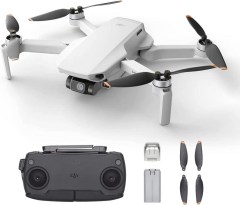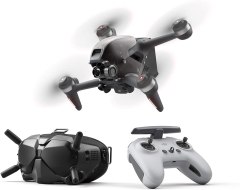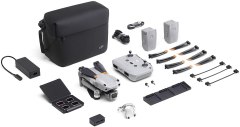Buying guide for best dji drones
Whether you want a drone for a hobby or for work, there are plenty of models available. And if you’re looking for a reliable drone, you’ll want to stick with a well-known brand. One of the best drone manufacturers is DJI Technology. DJI drones are fun to fly, and they also take sharp-looking photos and videos.
DJI offers many different drone models, which means you can find a unit that meets your needs at a price point that fits your budget.
If you’re ready to learn more about DJI drone options, we at BestReviews have collected the information you need. This shopping guide can help you figure out which features are most important for your situation before you buy.
DJI drone features to consider
Camera
A camera drone is an unmanned aerial vehicle (UAV) that contains a built-in camera. Camera drones give you the ability to shoot video and still images and control it all with a remote. When you use a camera drone, you’re able to view the world in an entirely new way. You can see and record locations and perspectives not normally accessible. DJI has a large number of camera drones available.
To compare one camera drone to another, pay attention to the camera-related features in each model’s specification list. A drone with a better camera excels in the following.
-
Image sensor: A half-inch image sensor is about average when it comes to drone cameras, while a one-inch image sensor is above average. The larger size of the image sensor plays a huge role in the quality of the images.
-
Still-image resolution: A camera with a resolution of at least 12 megapixels will yield above-average results.
-
Movie resolution: Most newer drones can record and store movies with 4K video resolution, although 1080P is more common and “standard”.
-
ISO rating: A drone camera with a higher ISO number (such as 800, 1600, or higher) will perform well in low-light situations.
- Lens: Some drones have a zoom lens feature so you can magnify a scene without moving the drone too close.
Gimbal
The gimbal mechanism determines the stability of the camera on a drone. Entry-level drones have a two-axis gimbal, which doesn’t offer perfectly smooth video recording. Look for a DJI drone with a three-axis gimbal for the best results.
Wireless transmission
Most DJI drones give you the ability to see the live view from the drone’s camera on your smartphone or remote control screen. The best transmission systems operate over two frequency bands, so you can choose the one that has minimal interference each time you fly. Transmission distance is important, too, because it determines how far from the remote the drone can fly.
Flight features
You can find DJI drones with a few different features that make them easier and safer to fly. If you’re a novice, having some of the following features in your drone can help you avoid problems
-
Collision avoidance: This can help the drone automatically avoid trees and buildings.
-
Flight time: The battery capacity determines how long your drone can fly in one session before needing to recharge. Batteries that last 20 minutes or more are above average.
-
Return to home: This brings the drone back to you when the battery drains to a certain point. This feature helps make sure that you’ll never have so little battery power left that the drone can’t fly back to base.
- Tracking: Some DJI drones have a camera with a built-in tracking feature. The drone can fly automatically and keep the subject you’re tracking in the frame.
DJI drone prices
When purchasing a DJI drone, you can expect to pay between $500 and $2,000, with the more feature-rich drones at the higher end of that range. You can find drones from other manufacturers for less, but sticking with a well-known manufacturer like DJI has a few advantages, even if you pay more. DJI drones contain higher-quality parts than inexpensive brands, giving you better performance and longevity. More importantly, it will be easier to find name-brand replacement parts when you need them. If you purchase a little-known brand of drone, replacement parts could be scarce, making repairs difficult.
Entry-level drones
You can expect to pay between $500 and $1,000 for an entry-level DJI drone. These are aimed at beginners and have everything you need to start using them immediately, including remote and battery. Some of the newer entry-level drones can record 4K video, but HD video is more common.
Advanced drones
You can expect to pay $1,000 to $2,000 for a more advanced DJI drone. All of these drones have cameras with 4K video resolution. They also ship with a battery and remote control, so you can begin using them immediately. Some of these drones also come with goggles, multiple batteries, and other advanced accessories to make them easier to operate.
Ongoing costs
Depending on how often you use your drone and how many extra accessories you want, your ongoing costs could run anywhere from $50 to $300 per year.
-
Batteries: You might need replacement batteries after a year or two. If you want to be able to fly your drone for longer periods of time, you’ll want to purchase extra batteries immediately. (Most drones are limited to 20 to 30 minutes of flying time on one battery charge.)
-
Goggles: Some people prefer using goggles to control the drone rather than a remote control. Most kits don’t ship with goggles, so you’d have to pay for them separately.
-
Propeller guards: You might want to add propeller guards to protect these delicate parts of the drone.
-
Memory card: You’ll also need a memory card to store the photographs and videos recorded by the drone’s camera.
- Repairs: No matter how careful of a pilot you are, you’re going to crash the drone at some point, which means you’ll have repair costs and need to purchase replacement parts occasionally.
FAQ
Q. How can I keep my DJI drone safe from crashes?
A. Careful piloting can only take you so far when trying to keep your drone safe. Sometimes, a crash simply isn’t avoidable. If you want to reduce your chance of crashing the drone, look for a DJI drone that has an advanced obstacle-avoidance system. Also, the quality of the remote control plays a big role in helping you control the flight path properly.
Q. How do I know if the DJI drone has a high-quality camera?
A. The image sensor (the chip that records the photos and videos) is the key component of any digital camera, including a drone camera. Image sensors are available in a few different sizes, and larger ones will outperform smaller ones – but bigger isn’t always better. Read through the specifications for the DJI drone to find the image sensor size.
Q. Do I want a large or small DJI drone?
A. A larger drone will give you a smoother flight than a smaller drone because the wind won’t affect the heavier drone as much. However, on average, a larger drone costs more upfront. If you want to transport the drone to remote locations, a large drone can be difficult to pack and carry over long distances. For travel or hiking, a smaller, lighter drone is preferrable.
Q. Why do drones have such short flying times?
A. Newcomers to drones might be surprised to learn that even top-level camera drones can’t fly more than 25 to 30 minutes without needing to recharge. Flying time for any drone is limited by the capacity of the unit’s battery. Recording video continuously reduces flight times, so drones that have cameras need even more battery power. Have extra batteries on hand so you can swap out a dead battery for a fresh one and continue flying.




















